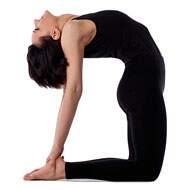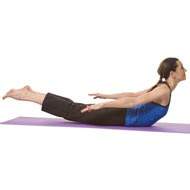Camel Pose - Ushtrasana
Yoga is an effective exercise option to relieve your body of daily stress, maintain your health, and stay in shape.
In fact, there are hundreds of poses (asanas) and breathing exercises (pranayama) that help you achieve heightened levels of agility as well as well-being in yoga.
Out of these poses, there is one pose in particular that can help you if you are suffering from any kind of back-related problems or are general feeling low- the Camel Pose (Ushtrasana), which has been described in detail below. Ushtrasana in Sanskrit literally means ‘Camel Pose’. A very powerful posture, theCamel Poseis an advanced pose meant for intermediate and advanced yoga practitioners. Apart from benefitting the back, if you are feeling low and tired, the Camel Pose can help you de-stress and relax the mind. This pose is said to benefit the circulatory, nervous, endocrine and the respiratory systems.
Steps
Enumerated below are the Camel Pose steps. Strict supervision is required if you are an intermediate yoga practitioner.
- With your knees apart at a width equal to the distance between your hips, kneel down on the floor or yoga mat. Your thighs must be perpendicular to the floor.
- Now, slightly rotate your thighs inwards, while narrowing your hip points. Make sure that your buttocks are not stiff. To understand this better, imagine yourself drawing the bones you utilize for sitting, upwards and into your upper body. Keep your outer hips relaxed and loose. Finally, press the top of the feet and the shins onto the floor tightly.
- Next, place your hands on your buttocks. Your fingers should pointing in the downward direction, and the base of your palms should be on the top of your buttocks.
- Spread your back pelvis using your hands. Further, lengthen down the back pelvis to the tail bone. Gently, try to move the tail bone forward towards the pubis. While doing this, make sure that your groin does not move in the forward direction. In order to prevent this from happening, press down on the front of your thighs. This will counter the forward action of the tailbone.
- Press the shoulder blades against the back ribs and lift your head. While lifting your head, inhale deeply.
- The next step is to lean back by using support from the firm tailbone and the shoulder blades. Now keeping the thighs perpendicular to the floor, you will have to touch both your feet with your hands simultaneously. Beginners will find it very hard to drop straight into this posture.
- Tilt your thighs backwards, and simultaneously twist your body to one side as little as you can, to be able to touch your right feet with your right hand.At this point your left hand is fully stretched behind your back. Now, return your thighs back to a perpendicular level and your torso back to a neutral angle.
Repeat the step in order to touch your left foot. Alternately, you can also turn your toes inwards and raise your heels to reach the foot if you are unable to bend backwards enough. - Extend your chest towards the ceiling and lift your pelvis. At this point you can feel you’re the back of your ribs veering away from your pelvis. With your fingers pointing towards your toes, press the soles of your feet firmly with your palms. The elbow creases must face forward. You have the choice of dropping your head back further or letting it be in the neutral position.
- Hold this pose for a full 30 seconds. As you get a little more comfortable you will be able to hold it for up to aminute. Start your exit by bringing your hands towards your pelvis. Lift your torso and head up by pushing the pelvis downwards. Inhale while doing this.
- Rest in a Child’s Pose (Balasana) for a minute.
Precautions
Since it is an advanced pose, there are several precautions which you must take when attempting to perform the camel pose.
- This pose is not for those suffering from high blood pressure or migraines.
- Patients suffering from insomnia should also avoid this yoga pose.
- This pose can cause serious back and neck injuries, so guidance from an experienced instructor is recommended.
Beginner’s tip
You tend to strain your back and neck a lot in this pose. A beginner’s tip for camel pose would be to keep a chair above the feet and touch the base of the chair with your hands instead of your feet.
Benefit to specific body parts
The entire frontal section of the body is stretched to the maximum along with the groin, ankles and thighs. Benefits include:
- Strengthening of the arms and shoulders
- Relieves mild pain in the back
- Expands the rib cage
- Improves blood circulation to brain
Therapeutic Applications
Listed below are the therapeutic applications of the Camel Pose:
- Respiratory ailments
- Mild pain in the back
- Anxiety and fatigue
- Menstrual discomfort
Variations
There are many variations for the Camel Pose; listed below are a few.
- Chair camel: Touch the edge of the chair instead of the feet, as mentioned in the Beginner’s tip section.
- Wall camel: Touch a wall behind you with your head and place the palms on the wall.
- Cross camel: Touch your feet with opposite hands.
Preparatory Poses
The camel pose is an advanced pose, it requires a bit of conditioning before you attempt it. Preparatory poses for the Camel Poseto prevent any injury are as follows:
- Cobra Pose (Bhujangasana)
- Locust Pose or Grasshopper Pose (Salabhasana)
- Bow Pose (Dhanurasana)
- Reclined Hero Pose (Supta Virasana)
- Bridge Pose (Setu Bandha)
- Hero Pose (Virasana)
- Upward Facing Dog Pose (Urdhva Mukha Svanasana)
Follow up poses
It is necessary to relieve the muscles of the tension built up after performing the Camel Pose. In order to do that, there are follow up poses that should be performed after performing the Camel Pose. Some of these are as follows:
- Staff Pose (Dandasana)
- Locust Pose or Grasshopper Pose (Salabhasana)
- Bridge Pose (Setu Bandha) (Setu Bandha)
- Supported Headstand (Sirsasana)
- Upward Bow Pose (Urdhva Dhanurasana)
- Hero Pose (Virasana)



